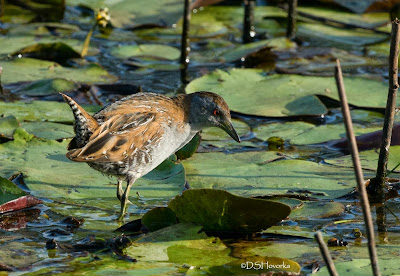 |
| Russet-tailed Thrush |
We had been planning for ages to get ourselves up to Inskip Point, just south of Fraser Island. We wanted to see if we could spot a rare little bird that is endemic to Eastern Australia, the Black-breasted Button-quail. Whereas this area has been known as being the best place to see these birds in Australia, its habitat is rare and fragmented and the birds are vulnerable to population-collapses (local extinctions). Unfortunately, we may be too late at this locale. We subsequently found out that the general consensus is that the local population has crashed, and only 1-2 birds may be left in the area. While wild dogs and goannas have been blamed, we were shocked at the number of people and vehicles in the area, and the condition of the habitat--toilet paper was strewn about, and the small area appears to heavily impacted by people and traffic. Despite two days of searching, we didn't see any of the birds. We did find platelets, areas where the buttonquails scratch the ground looking for bugs. Dogs, cats, large lizards, people, cars...a lethal mix for little ground-dwelling sedentary birds, the odds aren't good this population will recover.
 |
| Russet-tailed Thrush |
 |
| White-eared Monarch |
We tried to let the other lovely birds in the area cheer us up. These Russet-tailed thrushes were hopping about on the ground, see how cryptically they're colored? Every time we saw them we hoped for buttonquails, but really they're nice enough birds in their own right. We ID them as Russet-tailed thrushes...the Bassian thrushes look similar, but live at higher elevations. You can't get much lower in terrestrial elevation than sea-level.
We were totally surprised to find two White-eared Monarchs--a new
species for us. These birds are infrequently found this far south,
they're more of a tropical species. We didn't find them when we were
looking for them up in the tropical Cairns area last year, so
were pleased to hear them singing and see them cavorting about. This
bird was generous to pose nicely, but briefly, for us--enough to get the
all-important ID!
 |
| Leaden Flycatcher (female) |
This female Leaden Flycatcher is more brightly colored than her
partner--he doesn't have the pretty rufuous throat that she does. The
leaden grey does reach further down the male's breast.
 |
| Mangrove Honeyeater |
 |
| Varied Triller |
 |
White-cheeked Honeyeater
|
Here's a new bird for Dirk. A Mangrove Honeyeater works for his breakfast--he sips each individual flower at lightning speed.
We like seeing Trillers, but don't have the opportunity to see them very often. They're just not around that much so, it's a pleasure to spot them--they're pretty birds and have a nice call.
A White-cheeked honeyeater is feeding on the nectar from a
Xanthorrhoea
(grass tree) flowering spike. It was a treat to see plants blooming in
the heath along Cooloola Way in Great Sandy National Park. While these honeyeaters were the most commonly-seen bird in this area, we didn't get tired of watching them. Don't they sport a brilliant plumage?
 |
| Eastern Curlews |
Funny that we always think of shorebirds as 'mellow' types. I mean, geez...these Eastern Curlews just flew 12,000 km from Siberia, you'd think they'd be tired enough not to fight. But maybe that's the problem. We know I get cranky when I'm hungry--maybe they're fighting over territory in their feeding grounds. 'Endless summer' lovers, they divide their time between the northern and southern hemisphere summers.
 |
| Ballion's crake |
Dirk insisted we stop off in Brisbane in the hope we'd find a recently reported nomadic/migratory bird, the Ballion's Crake. Luckily, they cooperated and hung out just for us! We found three of them feeding in the late afternoon out in the open on the lily pads. Surprising hard to spot when the wind is rustling the lily pads (they are tiny), they are wonderfully beautiful birds--gotta love that clear red eye and pajama-stripey butt!
 |
| Ballion's crake |











1 comment:
Cool new bird pics, nice! Sorry you didn't get to see your Quail...
Post a Comment